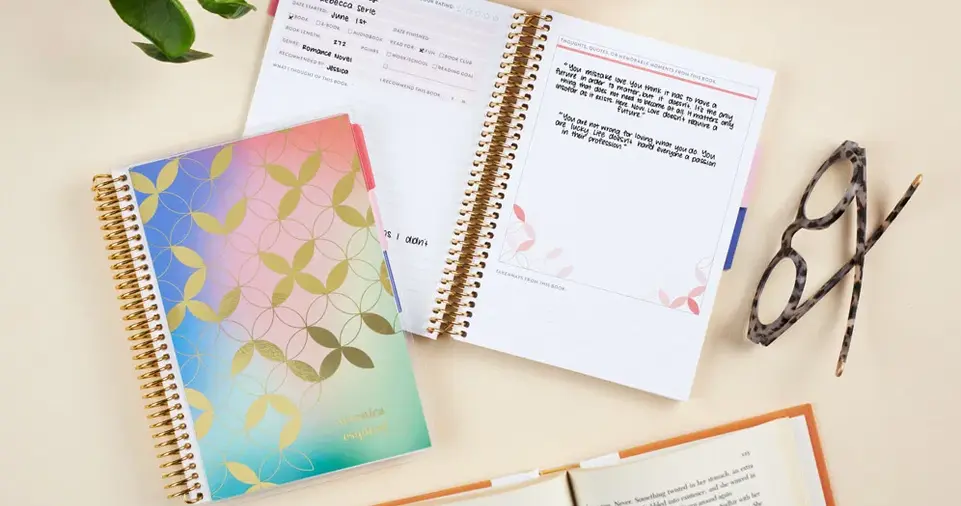A book journal is more than just a reading log; it’s a personal space to capture your thoughts, emotions, and insights from the books you read.
Whether you’re an avid reader looking to track progress, a student analyzing literature, or someone who enjoys reflecting on books, keeping a book journal can significantly enhance your reading experience.
By maintaining a journal, you can develop a deeper understanding of the books you read, discover patterns in your reading habits, and even create a valuable resource for future reference.
However, many people start a book journal only to abandon it after a few entries. The key to maintaining a book journal is to make it engaging, personalized, and easy to use.
In this guide, we’ll walk you through the process of starting and maintaining a book journal that you’ll actually enjoy using.
We’ll cover choosing the right format, setting up a practical structure, and making it a long-term habit so that your journal becomes a cherished part of your reading journey.
By the end, you’ll have all the tools necessary to create a journal that enhances your literary experiences and inspires you to continue reading and documenting your insights.
Choosing the Right Format for Your Book Journal
Physical Journal vs. Digital Journal
One of the first decisions you’ll need to make when starting a book journal is whether to use a physical notebook or a digital platform.
Both options have their advantages and can be tailored to suit your personal preferences.
Physical Journal:
If you love the feel of pen on paper, a physical journal might be the best choice.
Many readers enjoy the tactile experience of writing down their thoughts in a notebook, sketching book-related illustrations, or adding decorative elements like stickers and washi tape.
You can personalize it to your liking, using different colored pens, post-it notes, and even handwritten fonts.
Digital Journal:
If you prefer convenience and accessibility, a digital journal is a great alternative.
Apps like Evernote, Notion, or even Google Docs allow you to organize your notes, search past entries easily, and sync across multiple devices.
Some apps also offer templates, voice-to-text features, and cloud storage, making it easier to maintain your journal without worrying about losing entries.
Hybrid Approach:
Some people use a combination of both. For instance, you could maintain a physical journal for creative entries and use a digital platform for quick book logs and references.
This can be useful if you want to keep a structured digital archive while also enjoying the artistic aspect of a handwritten journal.
Online Platforms for Book Journaling
If you enjoy sharing your thoughts with a reading community, consider using an online platform like:
Goodreads:
Allows you to rate books, write reviews, and track reading goals. It also connects you with fellow readers and provides recommendations based on your reading history.
StoryGraph:
A data-driven alternative that provides personalized recommendations based on your reading habits. It includes mood-based tracking and in-depth analytics.
Personal Blog or Website:
If you love writing, starting a blog about your reading journey can be an excellent way to stay committed.
Platforms like WordPress, Medium, and Blogger allow you to share your book reviews with a broader audience.
Social Media Accounts:
Some readers document their book journaling journey on Instagram, TikTok, or Twitter by posting book reviews, aesthetic journal pages, and interactive book discussions.
Structuring Your Book Journal for Maximum Effectiveness

Essential Sections to Include in Your Journal
A well-structured book journal should be easy to navigate and should contain sections that enhance your reading experience.
Here are some essential sections you might want to include:
Book Details
This section acts as a quick reference guide.
Include information such as:
- Book Title
- Author
- Genre
- Date Started & Finished
- Number of Pages
- Format (Paperback, Hardcover, E-book, Audiobook)
- Publisher & Year of Publication
- Book Cover Image (if using a digital journal)
Book Summary
A brief summary of the book helps you recall the storyline. Try summarizing in your own words instead of copying from a synopsis.
This will help you engage with the book’s themes and concepts more deeply.
You can also break the summary into sections such as:
- Plot Summary: A concise overview of the main events.
- Main Characters: Key figures in the book and their development.
- Themes & Motifs: The central ideas explored in the book.
Favorite Quotes
Books often contain thought-provoking passages, beautiful writing, or memorable dialogues.
Dedicate a section to writing down quotes that resonate with you.
You can categorize quotes by:
- Philosophical insights
- Emotional impact
- Writing style
Personal Reflection & Analysis
This is the heart of your journal.
Reflect on:
- How did the book make you feel?
- What themes stood out to you?
- Did the book change your perspective on something?
- What were the most memorable scenes or characters?
- Did you agree with the author’s message or approach?
- How does the book compare to others you’ve read?
Book Ratings & Reviews
Rate the book on a scale (1-5 stars, 1-10 scale, emojis, etc.) and write a short review explaining your rating. Be honest about what you liked or disliked.
You can also create a rating system based on factors like:
- Plot Development
- Character Depth
- Writing Style
- Emotional Impact
Connections to Other Books
This section helps you find patterns in your reading.
You can note if a book reminds you of another book you’ve read, whether they share similar themes, writing styles, or characters.
Making these connections can deepen your understanding of literary trends and personal preferences.
To-Read List & Reading Goals
Track books you plan to read in the future and set goals, such as “Read 50 books this year” or “Explore more classic literature.”
You can also break your reading goals into categories:
- Number of books per year
- Books by a specific author or genre
- Exploring books from different cultures or languages
ALSO READ: E-Readers vs. Tablets: Which One Is Right for You?
Making Book Journaling a Habit
Set a Journaling Schedule
To stay consistent, establish a routine for updating your book journal.
Some ideas include:
- Writing after every reading session
- Summarizing once you finish a book
- Scheduling a weekly reflection time
- Setting reminders in your calendar
Keep Your Journal Accessible
- Place your physical journal in a visible location, such as your nightstand or desk.
- Use a notes app on your phone for quick thoughts if you’re keeping a digital journal.
- Create bookmarks or tabs in your digital journal for easy organization.
Use Prompts to Guide Your Entries
If you ever feel stuck on what to write, use prompts like:
- “What was the most surprising part of this book?”
- “Which character did I relate to the most and why?”
- “Would I recommend this book to a friend? Why or why not?”
- “What would I change about this book if I were the author?”
ALSO READ: Top Audiobook Platforms Compared: Audible vs. the Rest
Conclusion
Starting a book journal can be an incredibly rewarding experience, helping you engage more deeply with the books you read while preserving your thoughts for years to come.
Whether you choose a physical notebook, a digital platform, or a combination of both, structuring your journal in a way that suits your style is key to making it a lasting habit.
By incorporating creative elements, setting up an easy-to-follow format, and reflecting on your entries regularly, you’ll create a journal that not only enhances your reading journey but also serves as a treasured personal archive.
So, grab your journal and start recording your literary adventures today!

